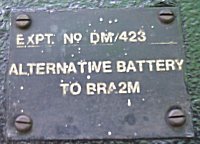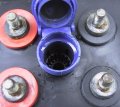Batteries
Types
by John Joyce
Assorted types of batteries have been used over the years on DMUs, mostly lead acid but with a few nickel-iron ('NiFe'). I've little experience of the NiFe ones other than replacing them with lead acids! They are the same types as fitted to the 24 volt hauled coaching stock, eg mark 1s.
The earliest type was the black rubber-cased BRA2, with two filler caps, four terminals, and a float to indicate electrolyte level. Few of these remain today as they appear to have been superseded in the late 1980s by plastic-cased cells in wooden crates. Early types of these retained the handy float level indicators, although they had to be removed for topping-up purposes. These appear to have been discontinued and replaced by simple lids, making topping-up a bit of a hit and miss affair. Later still came flip-cap fillers, which do have level markings, but these are often difficult to see without lifting the cells out.



The first three images show the original type black rubber type, (these dating from around 1978). These were under a Mark 1 and are the smaller 'BRA1' type (235amp-hour nominal) whereas DMU vehicles had the larger (395amp-hour) BRA2 type. The first two pics illustrate the float, first at empty and then at full, and also the filler caps. The third pic shows the cells all coupled. The first pic also shows the top lifting away as they tend to do when they get towards the end of their life. Not pleasant as the acid starts to escape!




The four images above show a set of Crompton flip-cap batteries that were fitted to a Class 115 power car. 1) Plate on battery box; 2) Close-up of filler cap. The level marks can be seen - at the bottom of the filler, and the step part way up; 3) A single cell, Crompton manufacture; 4) A set of Crompton flip-cap cells.




The four images above: 1) earlier Crompton type which replaced the BRA2. No filler levels at all which isn't very useful; 2 & 3) 'Oakdale' type which look similar to the Crompton ones, but don't have the filler levels either; 4) A set of Oakdales.


